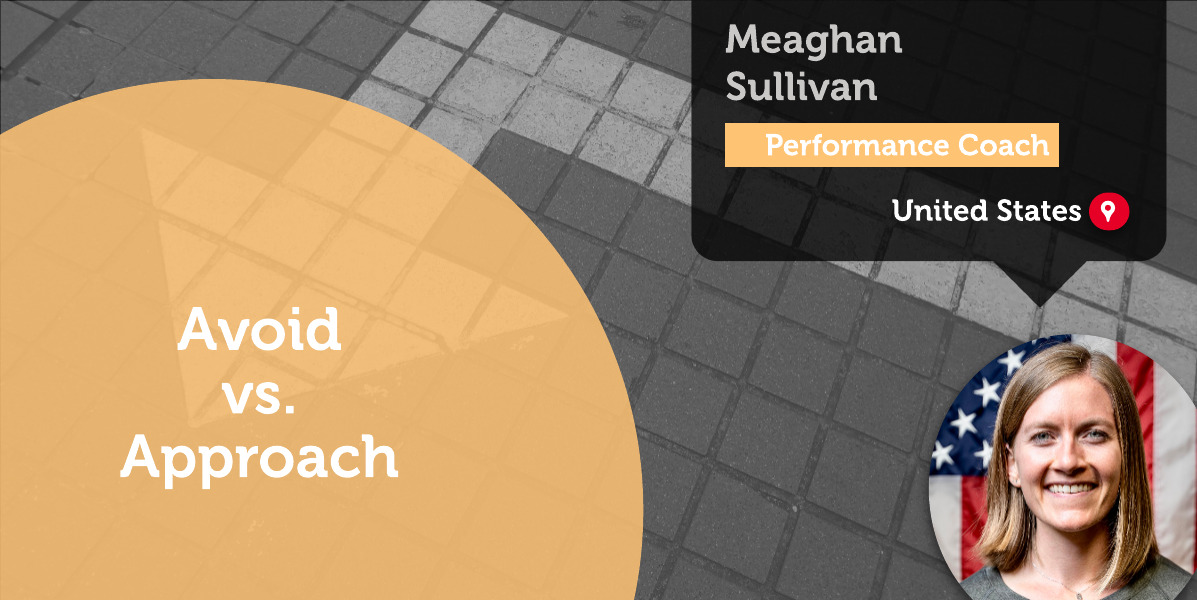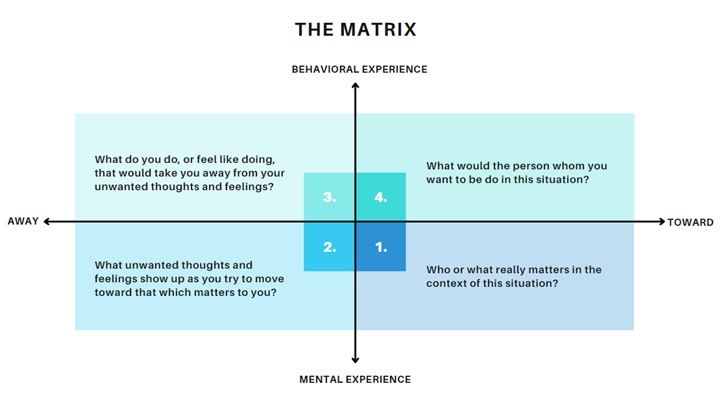A Coaching Power Tool By Meaghan Sullivan, Performance Coach, UNITED STATES

How to Avoid vs. Approach a Situation
Adrian, a collegiate baseball player, is afraid to fail. Every time he is up to bat, all he can think is, “Don’t strikeout. Don’t strikeout. Don’t strike out.” He has played baseball his whole life, but now that he has made it to the collegiate level, the stakes feel higher. The thought of being seen as a failure by his coach, teammates, and family is all-consuming, and it shows in his poor performances.
Sofia, a wife, and mother of three are afraid to bring up a difficult yet very important topic with her husband about one of their children. Although she deeply values her marriage and the well-being of her family, she finds herself avoiding the topic whenever her husband is around because she doesn’t want him to become upset. The mere thought of her husband’s potentially adverse reaction is enough to prevent Janet from having the conversation.
Gabriel, a recent college graduate, is nervous to interview for his first job. He feels like a fraud and is certain the hiring team will see right through him. He knows he must earn an income, and he’s passionate about his field of study, but the thought of rejection is keeping him from applying for jobs.
Kai, an aspiring stand-up comedian, has severe anxiety whenever she goes on stage. She has always wanted to work in comedy, but now that her opportunity is here, she feels scared to follow through. In her mind, it’s safer to say no to new gigs so she doesn’t embarrass herself.
As these examples illustrate, performance exists in many areas of life, whether it be in sports, job interviews, difficult conversations, or public speaking. Regardless of the performance domain, we often encounter internal obstacles in situations where we must be “on”. These obstacles present us with two choices: we can either move away from the obstacle to avoid something difficult, unpleasant, or uncomfortable, or we can move toward the obstacle, lean into any resulting discomfort, and develop a plan to work through it. In short, we can either avoid it or approach it.
Explanation: Avoid vs. Approach
Avoid
Avoidance behaviors stem from our natural urge to move away from, or avoid, anything that may be undesirable or uncomfortable. From a performance perspective, rather than pursuing a valued outcome, we are more concerned with avoiding consequences (e.g., failure), uncomfortable situations (e.g., being rejected), or unwanted emotions (e.g., fear or embarrassment). While avoiding such outcomes may feel like an act of self-protection, avoidance behaviors like these ultimately prevent us from taking meaningful action and stunt our personal or interpersonal growth.
Here are a few examples of what AVOIDANCE language sounds like:
- I don’t want to mess up.
- I don’t want to fail.
- I don’t want to get fired.
- I don’t want to embarrass myself.
- I don’t want to think this way.
- I don’t want to feel this way.
- I don’t want to look dumb.
- I don’t want to jeopardize my relationship.
In each of these examples, the emphasis is on what NOT to do, or what we want to avoid. However, when our actions stem from a place of avoidance, our energy and attention are consumed by the very thing we don’t want to happen. As a result, we are not focused on or invested in what we want to do or be. This performance-avoidance orientation is associated with low motivation, increased anxiety, greater fear of failure, a tendency toward helplessness, and overall reduced success in coping with life’s challenges (Wimmer et al., 2018).
Approach
Approach behaviors are driven by a desire to engage in meaningful work to achieve a valued outcome. Rather than avoid unwanted thoughts, feelings, or potential consequences, we remain focused on what we aspire to accomplish, and we demonstrate a willingness to embrace discomfort. When we operate from an approach perspective, we keep our values at the forefront, and we honor those values through our actions.
Here are a few examples of what APPROACH language sounds like:
- I want to perform well.
- I want to pass my test.
- I want to earn my salary.
- I want to push myself and grow.
- I want to focus on what I control.
- I want to give my full effort.
- I want to be prepared.
- I want to be a reliable and supportive partner.
In each of these examples, the focus is on what we want to be or achieve. If we view attention as the currency of performance, we can see how investing our attention in behaviors that propel us toward a valued outcome will have a greater rate of return and increase our likeness of achieving that outcome. This performance-approach orientation has been linked with increased effort, persistence, and aspiration; greater absorption during task engagement; and the tendency to view obstacles as challenges rather than as threats (Elliot, 1999).
Avoid vs. Approach Effective Tool “The Matrix”
The Acceptance and Commitment Matrix, or “The Matrix” for short, is a simple and effective tool that helps us to (1) identity what we value, (2) explore what gets in our way, (3) reflect on how we generally respond to obstacles, and (4) generate ideas for productively working through those obstacles.

The horizontal axis of The Matrix represents the direction in which we move about our values (i.e., toward or away), while the vertical axis represents the quality of our lived experiences (i.e., internal/mental or external/behavioral). Starting in the bottom right quadrant and working clockwise, the client can reflect on four important questions:
-
Who or What Matters in the Context of This Situation?
This response will reflect the client’s values.
-
What Unwanted Thoughts and Feelings Show Up as You Try to Move Toward That Which Matters to You?
This response will reflect the client’s internal obstacles (e.g., unwanted thoughts and feelings) that may trigger avoidance behaviors.
-
What Do You Do, or Feel Like Doing, That Would Take You Away From Your Unwanted Thoughts and Feelings?
This response will reflect the client’s avoidance behaviors (e.g., running away, shutting down).
-
What Would the Person Whom You Want to Be Done in This Situation?
This response will reflect the client’s approach behaviors.
Regularly completing The Matrix enables clients to develop greater self-awareness, understand their typical responses to obstacles, and create more opportunities to take committed action. Due to its widespread applicability, The Matrix can help those who may feel stuck, as well as those interested in enhancing their current levels of high performance (Hill & Oliver, 2019).
Avoid vs. Approach Unwanted Consequences
Trying to control outcomes by avoiding unwanted consequences or preventing ourselves from taking action is exhausting and self-limiting. More importantly, it distracts us from what truly matters. To uncover what drives our behaviors, we must pay close attention to our language. The way we speak to ourselves makes a tremendous impact on what we focus on and how we act. By noticing our word choices, we can identify where our barriers lie and how we can work to overcome them. When we find that we are instructing ourselves not to do something, we should pause and ask ourselves, “What outcome am I trying to avoid?” followed by, “What outcome do I want to approach?”. With the latter response in mind, we can then consider, “What steps am I willing to take to move in this direction?”.
References
Elliot, A. J. Approach and avoidance motivation and achievement goals. Educational Psychologist
Hill, J. & Oliver, J. Acceptance and commitment coaching: Distinctive features. Routledge.
Polk, K. L. & Schoendorff, B. The ACT Matrix: A new approach to building psychological flexibility across settings and populations. New Harbinger Publications.
Wimmer, S., Lackner, H. K., Papousek, I., &Paechter, M. Goal orientations and activation of approach versus avoidance motivation while awaiting an achievement situation in the laboratory, Frontiers in Psychology